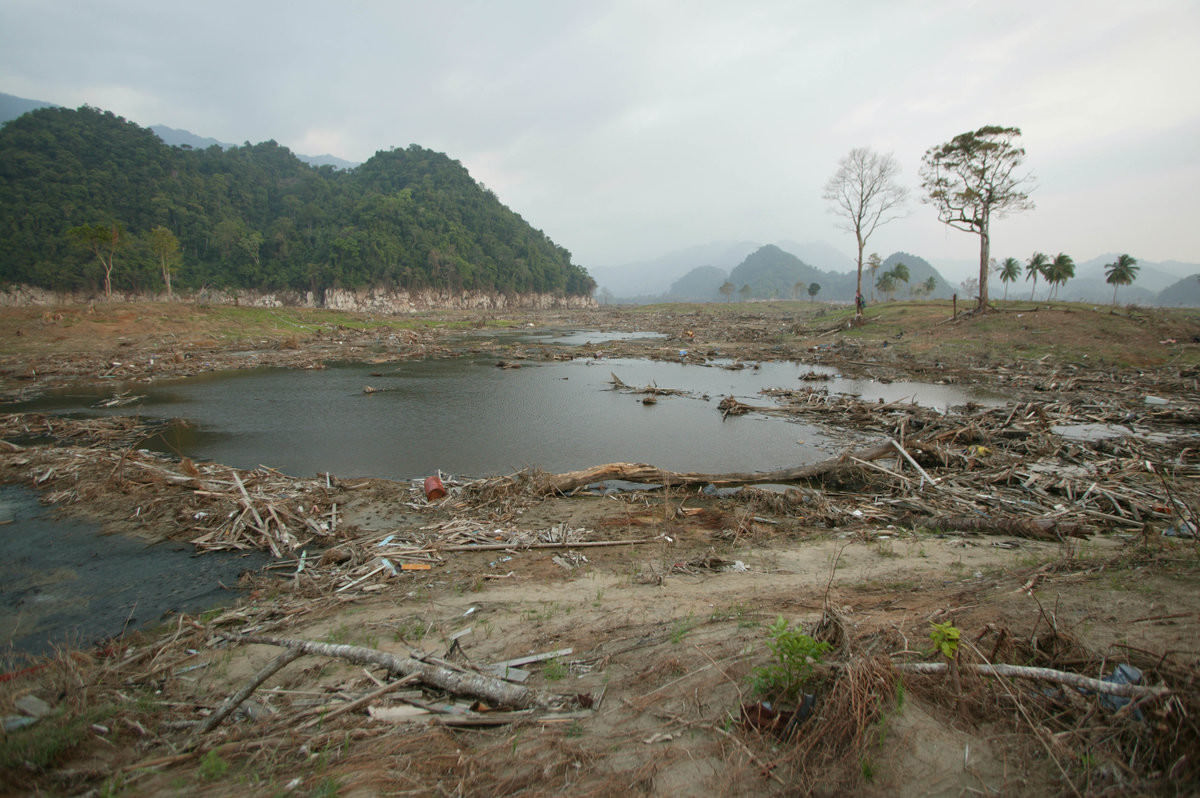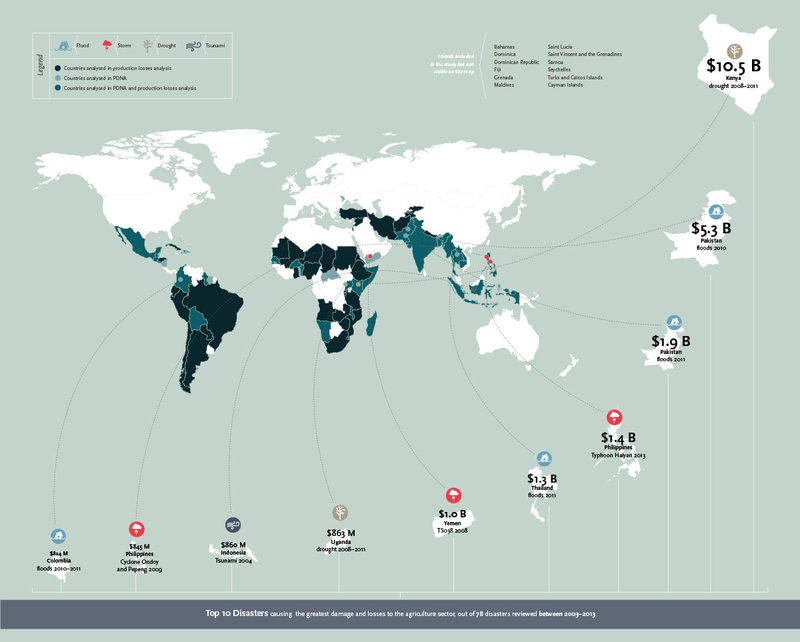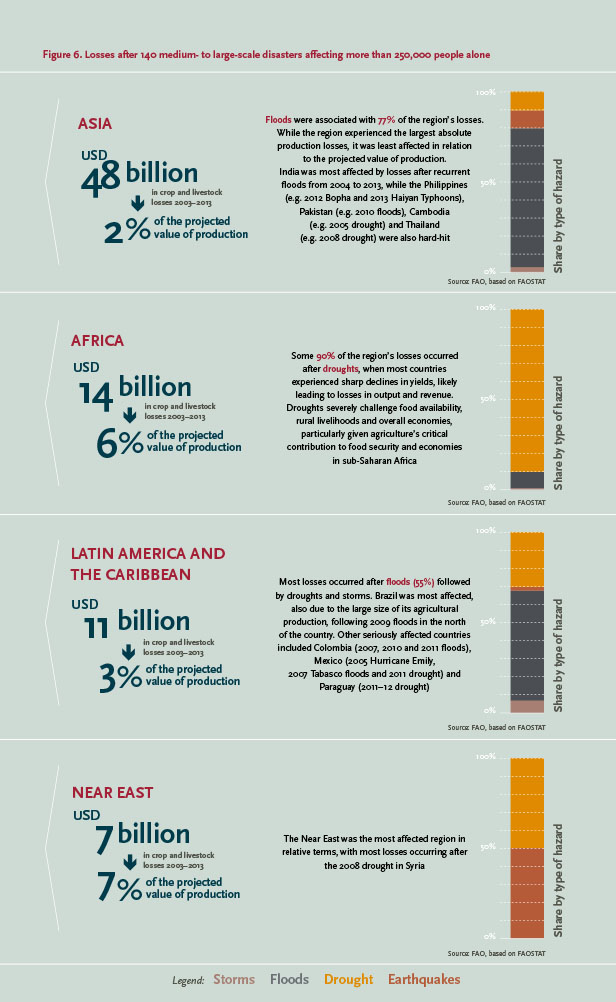The Price of Climate Change-Related Disasters on Agriculture Is Astronomical
A new UN study finds the cost of climate-change related disasters have cost the world $1.5 trillion, with agriculture bearing the brunt.
The Price of Climate Change-Related Disasters on Agriculture Is Astronomical
A new UN study finds the cost of climate-change related disasters have cost the world $1.5 trillion, with agriculture bearing the brunt.

The 53-page report, titled “The impact of disasters on agriculture and food security,” focuses on climate-related disasters in developing countries and finds that the agriculture sector – and thus food security – suffers the most. In general, crop, livestock, fisheries, and forestry bear 25 percent of the negative impacts from such disasters as droughts, floods, and tropical storms. In the case of droughts, more than 80 percent of damage and losses are borne by crop and livestock producers.
According to Stephan Baas, the FAO’s natural resources officer, it’s likely the global figures are higher than what was presented in this study since it solely focused on medium to large-scale disasters in Africa, Asia, the Pacific, Central America, and the Caribbean.
“The overall impacts are likely to be much higher, especially when including impacts of small-scale events as well,” Baas tells Modern Farmer in an email.
The FAO report is based on a review of 78 post-disaster needs-assessments conducted in developing countries as well as a statistical analysis of production losses, changes in trade flow, and agricultural sector growth connected with 140 medium- to large-scale disasters (those affecting at least 250,000 people). Among those included are the Indonesian Tsunami of 2004, which caused $860 million in agricultural losses; a series of droughts in Kenya from 2008 to 2011, with a loss of $10.5 billion; and flooding in Pakistan in 2010, with associated losses of $5.3 billion.

Baas says the report finds that the economic damage from climate-related disasters goes beyond losses of crops and farming equipment; it also includes the loss of facilities used for storage and processing, transportation, and even the government agencies that oversee agriculture. He cites the 2010 floods in Pakistan, which caused about $5 billion in damage, as an example. In that case, besides the 2.4 million hectares of unharvested crops (mostly cotton, rice, sugarcane, and vegetables) that were lost due to flooding, there were also negative impacts on cotton ginning, rice processing, and flour and sugar milling, among others.
“The floods caused a decline in both agriculture growth and overall Gross Domestic Product (GDP) growth. Livelihoods, food security, and nutrition were also strongly impacted: More than two-third of Pakistani farmers lost 50 percent of their expected income, and almost one-third of the population had poor consumption intake,” says Baas.
The data indicates a correlation between climate change and the increase in climate-related disasters such as floods, droughts, and storms.
A link is very likely between these disasters and climate change, according to Baas. The data indicates a correlation between climate change and the increase in climate-related disasters such as floods, droughts, and storms. But, at this point, the researchers still can’t say that climate is the only driver of enhanced risk; nor what additional percentage of an impact climate change plays in the severity and frequency of natural hazards. The Intergovernmental Panel on Climate Change, an international body for the assessment of climate change formed by the UN in 1988, is still working on that answer.
What we do know for certain is that these disasters have a direct impact on agricultural livelihoods, food security, and nutrition. Disasters can cause either unemployment or a decline in wages and income for farm laborers and lower the availability of food in local markets leading to inflation of food prices.
“Such pressures reduce the purchasing capacity of households, restrict access to food, deplete savings, force the sale of vital productive assets, increase indebtedness, and erode livelihoods,” Baas says. “Such negative cascading effects often lead to an increase in food insecurity and malnutrition, particularly among the most vulnerable households.”
There are also negative cascading effects along the value chain that can lead to additional costs for governments, including increased imports of food and agricultural commodities; reduced exports and revenues; and a reduction in manufacturing and industrial output in sectors that depend on agriculture and raw materials, such as food processing and textile industries.

The report was strategically released to coincide with the climate-change conference in Paris, which runs until December 11. The FAO believes that agriculture, food security, and nutrition are still not yet prominent enough in the climate-change talks, according to Baas.
Worldwide, the agriculture sector, while being hit the hardest by natural disasters, receives only a small portion of the total post-disaster humanitarian aid that finds its way to developing countries. Between 2003 and 2013, about $121 billion was spent on humanitarian assistance for all types of disasters and crises, with just 3.4 percent going to the agriculture sector, averaging about $374 million annually. Additionally, in certain parts of the world, notably Africa, governments aren’t investing enough in agriculture in general, according to the report.
“The main intention of the study was exactly to raise awareness is of what is at stake if we do not proactively put approaches and mechanisms in place to mitigate the impact of disasters on agriculture.”
“The situation simply reflects the priority setting in funding over the past two decades during which funding to agriculture went down significantly. This has to be reversed,” Baas says. “Currently 2.5 billion people worldwide depend on agriculture as the main source of their livelihoods. The main intention of the study was exactly to raise awareness is of what is at stake if we do not proactively put approaches and mechanisms in place to mitigate the impact of disasters on agriculture.”
While the FAO report gives us a good look at the issue of climate-related natural disasters 0n agriculture, there still needs to be more reporting in order to fully understand the problem. One big issue: There’s currently no standardized international system in place to monitor and report on how farming is affected by natural disasters, making it harder to assess associated needs.
“Systematic reporting is crucial to support the monitoring of progress towards the achievement of global and national goals and targets on disaster risk reduction and resilience,” Baas says. “In order to meet these challenges and as part of the Organization’s commitment to resilience, FAO is ready to support efforts to further improve monitoring and reporting of disaster impact on the agriculture sector.”
Here’s Dominique Burgeon, director of FAO’s Emergency and Rehabilitation Division, giving some of the report’s highlights:
Follow us

This work is licensed under a Creative Commons Attribution-NoDerivatives 4.0 International License.
Want to republish a Modern Farmer story?
We are happy for Modern Farmer stories to be shared, and encourage you to republish our articles for your audience. When doing so, we ask that you follow these guidelines:
Please credit us and our writers
For the author byline, please use “Author Name, Modern Farmer.” At the top of our stories, if on the web, please include this text and link: “This story was originally published by Modern Farmer.”
Please make sure to include a link back to either our home page or the article URL.
At the bottom of the story, please include the following text:
“Modern Farmer is a nonprofit initiative dedicated to raising awareness and catalyzing action at the intersection of food, agriculture, and society. Read more at <link>Modern Farmer</link>.”
Use our widget
We’d like to be able to track our stories, so we ask that if you republish our content, you do so using our widget (located on the left hand side of the article). The HTML code has a built-in tracker that tells us the data and domain where the story was published, as well as view counts.
Check the image requirements
It’s your responsibility to confirm you're licensed to republish images in our articles. Some images, such as those from commercial providers, don't allow their images to be republished without permission or payment. Copyright terms are generally listed in the image caption and attribution. You are welcome to omit our images or substitute with your own. Charts and interactive graphics follow the same rules.
Don’t change too much. Or, ask us first.
Articles must be republished in their entirety. It’s okay to change references to time (“today” to “yesterday”) or location (“Iowa City, IA” to “here”). But please keep everything else the same.
If you feel strongly that a more material edit needs to be made, get in touch with us at [email protected]. We’re happy to discuss it with the original author, but we must have prior approval for changes before publication.
Special cases
Extracts. You may run the first few lines or paragraphs of the article and then say: “Read the full article at Modern Farmer” with a link back to the original article.
Quotes. You may quote authors provided you include a link back to the article URL.
Translations. These require writer approval. To inquire about translation of a Modern Farmer article, contact us at [email protected]
Signed consent / copyright release forms. These are not required, provided you are following these guidelines.
Print. Articles can be republished in print under these same rules, with the exception that you do not need to include the links.
Tag us
When sharing the story on social media, please tag us using the following: - Twitter (@ModFarm) - Facebook (@ModernFarmerMedia) - Instagram (@modfarm)
Use our content respectfully
Modern Farmer is a nonprofit and as such we share our content for free and in good faith in order to reach new audiences. Respectfully,
No selling ads against our stories. It’s okay to put our stories on pages with ads.
Don’t republish our material wholesale, or automatically; you need to select stories to be republished individually.
You have no rights to sell, license, syndicate, or otherwise represent yourself as the authorized owner of our material to any third parties. This means that you cannot actively publish or submit our work for syndication to third party platforms or apps like Apple News or Google News. We understand that publishers cannot fully control when certain third parties automatically summarize or crawl content from publishers’ own sites.
Keep in touch
We want to hear from you if you love Modern Farmer content, have a collaboration idea, or anything else to share. As a nonprofit outlet, we work in service of our community and are always open to comments, feedback, and ideas. Contact us at [email protected].by Andrew Amelinckx, Modern Farmer
December 8, 2015
Modern Farmer Weekly
Solutions Hub
Innovations, ideas and inspiration. Actionable solutions for a resilient food system.
ExploreExplore other topics
Share With Us
We want to hear from Modern Farmer readers who have thoughtful commentary, actionable solutions, or helpful ideas to share.
SubmitNecessary cookies are absolutely essential for the website to function properly. This category only includes cookies that ensures basic functionalities and security features of the website. These cookies do not store any personal information.
Any cookies that may not be particularly necessary for the website to function and are used specifically to collect user personal data via analytics, ads, other embedded contents are termed as non-necessary cookies.